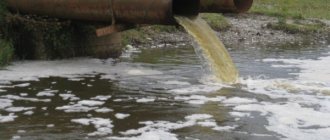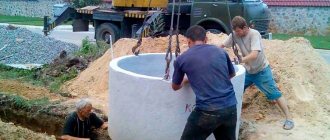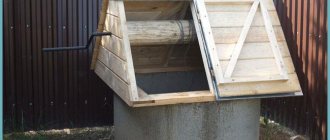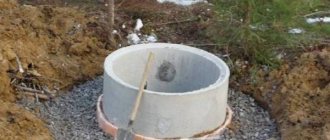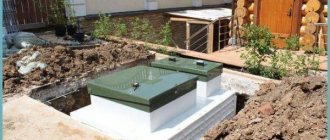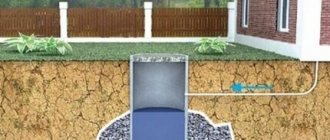A comfortable existence is impossible without sewerage. In a private house or country house this is usually a cesspool or septic tank. The second option is more environmentally friendly and safe - a septic tank. It decomposes waste into insoluble sediments, which fall to the bottom, forming silt, and fairly clean water, which is usually discharged into the ground for further purification. Probably the most popular option for this installation is a septic tank made of concrete rings. The technology for its construction is simple, you can build it yourself, and the cost is relatively low. This explains its popularity.
Instructions for selection and installation of VOCs
Its production and maintenance will cost less in comparison with factory analogues: a 3-section septic tank with a volume of 6 cubic meters with delivery of rings costs up to 40 thousand rubles, while its plastic counterpart costs from 80 thousand rubles without taking into account the delivery of the container and its installation.
In this article we will look at 5 typical designs for septic tanks made of reinforced concrete rings, which have proven themselves to be functional and durable.
Purpose of the article:
introduce the reader to the 5 main options for constructing wastewater treatment plants made of concrete rings. Describe in detail the schemes and technological solutions used.
Estimate for a “people’s” septic tank made of concrete rings
Expenses:
- Concrete rings, including delivery, - 33,500 rubles;
- Tunnels - 30,000 rubles;
- Excavator rental - 8,500 rubles;
- Manipulator - 8000 rub.;
- Soil removal - 11,000 rubles;
- Sand - 17,500 rubles;
- Crushed granite, fraction 5-20, 10 cubic meters – 18,500 rubles;
- Salary for hired workers – 18,500 rubles;
- Consumables - 6,700 rubles;
- Well, hatches, tees, bends - 6400 rubles;
- Extruded polystyrene foam and geotextiles - 5,700 rubles;
- Sealant - 2800 rub.;
- Additional rings and DSP - 900 rub.
Total: 168 thousand rubles.
Basic information
We will present the basic requirements for installing external sewerage using reinforced concrete rings in the form of several postulates, from which we will subsequently build when considering septic tank designs. If you don’t agree with them, write reasoned answers in the comments, we’ll figure it out together
Postulate 1. Position correctly
Choose a place for the septic tank on the highest area of the site. This is necessary so that stormwater does not flow into it.
For the placement of the septic tank, see SP 32.13330.2012, the distances to it should be as follows:
- from the house – 5 m;
- from the reservoir – 30 m;
- from the river – 10 m;
- from the well – 50 m;
- from the road – 5 m;
- from the fence – 3 m;
- from the well – 25 m;
- from trees – 3 m
Postulate 2. Look at the groundwater level
If the groundwater level (GWL) is high, i.e. water accumulates in the pit already at a depth of 1-1.5 m, then this is a reason to think about choosing a different septic tank design, possibly a plastic septic tank or a biological treatment station. We described in detail about ready-made VOC options in this article.
If you have firmly settled on wells, then you should wait until the groundwater level is lower. For example, in summer or winter. This will simplify the development of the pit and the construction of wells: you will not stand knee-deep in water and will be able to properly concrete the bottom and seal the seams between the rings.
Postulate 3. Calculate the volume of the septic tank with a margin
Carefully calculate the volume of the septic tank. Please note that the rule according to SP 32.13330.2012, in which the volume must be greater than 3 times the volume of wastewater discharged into the sewer per day, is valid only on sandy soils and at low groundwater levels. The rules assume that 1 person per day will discharge 200 liters of wastewater. This means that in this case you need a septic tank with a volume of 600 liters.
In other cases, the worse the soil drains, the larger the volume of the septic tank.
There is a working rule: for a family of 4-5 people with permanent residence, depending on the soil, the septic tank will be 30 m³ - on clay, 25 m³ - on loam, 20 m³ - on sandy loam, 15 m³ - on sand. Calculation of septic tank volume
| Number of people | Septic tank volume, m³ (working values) | |||
| Sand | Sandy loam | Loam | Clay | |
| 1 | 4 | 7 | 10 | 15 |
| 2 | 7 | 12 | 17 | 22 |
| 3 | 10 | 15 | 20 | 25 |
| 4 | 15 | 20 | 25 | 30 |
| 5 | 15 | 20 | 25 | 30 |
| 6 | 17 | 23 | 27 | 35 |
| 7 | 20 | 25 | 30 | 35 |
It is necessary to vary the volume of the septic tank not by the depth of the wells, but by the diameter of the rings. Those. if you have a choice of rings with a diameter of 1.5 m and a height of 0.9 m, or a diameter of 1 m and a height of 0.9 m, then it is better to take the former. Fewer quantities will be required to obtain the required volume. This means that a pit will not be as deep and there will be fewer seams in the wells.
Postulate 4. Hire people to develop a pit
If you are not a 20-year-old young man, and you do not have a couple of similar assistants ready to work for barbecue and beer, then entrust all excavation work to hired workers or hire an excavator.
The pit must be larger than the volume of the treatment plant, i.e. the distance from the wells to the walls of the pit is 30-50 cm. Subsequently, this volume must be filled with sand and gravel mixture (SGM) or sand.
Postulate 5. Order rings with delivery and installation
Order rings only after the foundation pit is ready. Immediately with installation, i.e. a truck with a crane should arrive.
All lower rings must have a bottom. They are available in a factory version - convenient and reliable. The exception is filter wells, which are made on well-draining soils. But under no circumstances should you do this
like the picture below!
After 1-2 years, the bottom of the filter well silts up and does not allow drainage to pass through; you have to call a sewer truck to clean the well, but this does not provide a long-term effect.
Postulate 6. Use only red pipes
Pipes are only red, with a diameter of 110 mm, for external sewerage. They need to be insulated only if in some area they are located in the open air. Anything in the ground does not need to be insulated.
Red pipes are specially designed for external sewerage. They are multi-layered and can withstand soil pressure. Gray pipes are intended for work inside the house; they are single-layer and the soil will simply crush them.
The pipes are laid in trenches on a compacted sand bed with a slope of 2 cm by 1 m. Avoid turns of 90 degrees, maximum 45. A layer of ASG or crushed stone 30 cm thick is poured on top and on the sides. Next is soil.
Postulate 7. The filtration field occupies a large area
A filtration field is needed at high groundwater levels; at low water levels, a filter well can be used. On average, expect that the drainage field area should be at least 10 m² per person.
It is appropriate to make a filtration well on well-draining soils: sand and sandy loam. On clay and loam, significantly larger areas are needed from which drainage will be carried out. Underground filtration fields allow this to be done.
Pipes on the filtration field must be laid with a slope of 1 cm by 1 m so that the treated wastewater has time to seep through the holes into the crushed stone layer.
Nuances of calculating the required volume of capacity
To organize a septic tank from concrete rings, it is necessary to calculate the volume based on daily water consumption. According to the standards, one permanent resident receives 200 cubic liters of water per day.
Image gallery
Photo from
Specifics of a single-chamber septic tank
Installation of three chambers in one well
Average volume of a two-chamber septic tank
Volume of multi-chamber septic tanks
The first container for settling wastewater should have a volume of at least three times the consumption (200 l) for each person. The second container with a bottom for settling should have a volume equal to 1/3 of the size of the first.
The rules for constructing a two-chamber treatment plant can be found in our other article.
The number of rings can be determined by dividing the volume of the container by the volume of the ring. Their sizes come in small, medium and large.
For the calculation, the parameters of an average-sized ring will be used. KS-10-9 whose internal diameter is 1 m and height is 90. One ring has a volume of 700 cubic liters
For a family of two:
Volume of the first container = (200*2)*3= 1,200 liters. Volume of the second and third containers = 1,200/3 = 400 liters.
Number of rings for two containers = (1200+400)/700= 4 Number of rings for three containers = (1200+400+400)/700= 5
Bottom line: 2 rings for the sump, 2 for the sedimentation tank and one for the drainage well.
For a family of three:
Volume of the first container = (200*3)*3= 1,800 liters. Volume of the second and third containers = 1,800/3 = 600 liters.
Number of rings for two containers =(1,800+600)/700=4 Number of rings for three containers =(1,800+1200)/700= 6
Result: 2 rings for the sump, 2 for the sedimentation tank and two for the drainage well.
The area is clayey, the groundwater level is low (water is below 4 m or there is none)
Clay soils are typical for the central zone. Where there is clay, groundwater and perched water are often found. However, hilly terrain may have clayey areas and low groundwater levels. Despite the low drainage capacity of clay, any volumes of pre-treated wastewater can be discharged into the ground.
Scheme 1. 3-chamber septic tank and underground filtration field
Description:
- Classic scheme with increased well volume.
- Suitable for any soil with low groundwater level.
- Requires more than 40 m² for the construction of underground drainage fields.
- A 2-level drainage field protects the system from volley discharge of wastewater.
- Pumping out from the first chamber no more than once a year.
In the video below, the author describes in detail the design of the treatment plant, explains the purpose of each of its components: settling tanks, distribution and inspection wells, ventilation, etc. You will learn about recommended tank sizes, the approach to primary settling and treatment in an underground filtration field.
Conclusion:
this simple scheme is applicable in most cases. The exception is high groundwater level. It is easy to maintain and has convenient access to any point in the system. However, you need to be prepared for extensive excavation work, which is needed not so much for installing a septic tank, but for drainage.
What is the difference between a septic tank without pumping?
What are the characteristic features of such a system? The answer lies in the operating principles. Wastewater undergoes a process of separation into liquid, which can subsequently be discharged into drainage, and solid components. It is solid waste that will eventually require pumping, but due to the fact that its volume will be much smaller, pumping can be carried out less often “no more than 6-9 years.” For subsequent disposal, waste coming from the sewer system of a country house requires separation - division into heterogeneous fractions. The use of special impurities in the process, which include enzymes, provides a significant increase in the service life of such a system, because thanks to the activity of organisms, aerobic and anaerobic bacteria, the sludge existing in the system is well processed into methane and carbon dioxide, which are discharged using a ventilation pipe mounted above the storage tank. According to the peculiarities of its design, a septic tank for a dacha without pumping is nothing more than a two-chamber waste disposal system, in other words, a two-chamber septic tank. The meaning of dividing one container into two chambers is as follows:
- sealed chamber - here the contaminated water entering the septic tank is received and settled without pumping directly from the house sewer system. Solid compounds settle and oily compounds rise to the surface. Due to this, the wastewater is partially purified and prepared for the next stage of treatment.
- second chamber - wastewater that has already undergone primary treatment enters here. Further disposal takes place naturally - the chamber has no bottom, therefore the liquid seeps into the soil through a special layer of gravel or crushed stone.
The huge demand for a septic tank for a dacha without pumping has led to the appearance on the market of a system with smaller dimensions, the so-called mini-septic tank. Such septic tanks for a dacha without pumping are budget versions of the usual ones that will allow installation of the system in fairly dense buildings, or in cases where the available area of the site is limited.
Septic tanks for summer cottages without pumping, budget treatment systems. A system with three chambers is not used so often, despite its greater efficiency, because the cost of such a system cannot be compared with a two-chamber septic tank. If the owner is concerned about the environmental side of the issue, then a treatment station will be the best solution. Such a station provides the highest possible level of purification; the water after treatment is suitable for watering and washing a car, and organic residues in the form of sludge are suitable as fertilizers. But there is also a significant disadvantage - such a system is energy dependent and requires expenses to maintain its functionality.
The area is clayey, the groundwater level is high (water at a depth of 1-1.5 m)
This happens more often than we would like. Not only is the soil clayey, but when digging a pit, the water is already a meter from the surface, and you still have to dig and dig. In this case, it is better to wait until the groundwater level drops seasonally and raise the level of the site in the area where the septic tank is installed. The idea is simple: if the GWL is high, then we will lower it locally.
Scheme 2. 3-chamber septic tank with bulk filtration field and pump
Description:
- Scheme of a volatile 3-chamber septic tank with a drainage or fecal pump and a bulk filtration field.
- Overflows must be above the ground level - this is important. Otherwise, ventilation will not work, and groundwater will constantly flow into the distribution well.
- Requires additional improvement of the filtration zone - you can arrange an alpine slide.
- The circuit can be simplified by eliminating the distribution well.
- If the seal of the wells is broken, the system fails, so sealing must be approached responsibly.
In the following video, the author explains the solution to the problem of installing a septic tank with a high water level using the example of an incorrectly constructed structure. This is the case when they first did it, and then discovered that the scheme did not work. The author proposes to correct the situation with a bulk drainage field and make a non-buried septic tank, without relying on its tightness.
Conclusion:
even with a high groundwater level, you can use a septic tank made of concrete rings. This will require retrofitting the classic layout with a pump for pumping treated wastewater for further treatment into a bulk filtration field. The most difficult thing in manufacturing this system is to install the wells and ensure their tightness at high groundwater levels. This can only be done if the ground level changes seasonally.
Scheme 3. 3-chamber septic tank in bulk soil
Description:
- Diagram of a non-volatile septic tank with a bulk platform for the entire system.
- Changes the terrain of the area, so it is not suitable for small areas.
An example of a similar solution, only with 2 wells. The author describes in detail each of the stages of work. If the GWL is even higher, then use more bulk soil.
Conclusion:
this scheme is suitable only if you have an idea of how to subsequently transform the meter-long embankments that will occupy a significant part of the site. But it works, doesn't need electricity, and that's the most important thing.
How to set up a sewer treatment system
First of all, the existing sediment from the precursor should be released into the finished septic tank (the optimal amount will be about 20% of the chamber volume). Then add special microflora that will work for your benefit and process the sediment from solids.
If you are building a septic tank from scratch and have no sediment, then its optimal performance will be noticeable after about 180 days.
How can you understand that the septic tank is already operating in the correct mode? The answer is simple: the smell of hydrogen sulfide gas will disappear. This is the surest signal! If used properly, the septic tank will last about 20 years, but periodic cleaning of the sand filters is necessary. And the useful life of filtration wells reaches 10 years.
It should be remembered that the number of chambers directly affects the service life of the septic tank as a whole.
The area is sandy, the groundwater level is low (water is below 4 m or there is none)
The combination of low groundwater level and well-draining soil are ideal conditions for constructing a septic tank made of reinforced concrete rings. Moreover, in this case, you can do without a filtration field, so the capabilities of a filter well are sufficient. There may be several design options; we have identified the simplest and most effective.
Scheme 4. 3-chamber septic tank with one hatch
Description:
- Compact 3-section septic tank with filter well.
- 1 hatch for servicing the entire system.
- Saving on additional rings - they are needed only for one well.
- Filter layer throughout the entire volume around the wells and between them.
- The bottom of 2 wells is concreted. There are no holes in the filter well, there are holes in the walls of the lower ring.
The following video shows the construction process without unnecessary comments. The main part of the work is carried out in 1 day. For increase
Conclusion:
This scheme saves space for installing external sewerage; there is no need to buy additional rings and hatches for 3 wells.
Scheme 5. 2-chamber septic tank with a filter well
Description:
- A simple diagram of a 2-chamber septic tank with a filter well.
- Can be installed and put into operation in 1 day.
- You can get by with wells made of two rings.
- The bottom of the first well is necessarily solid.
The simplified wastewater treatment scheme is due to the excellent drainage properties of the soil. In the video below, the author explains in detail the role of each structural element of the treatment plant. The video also contains a lot of food for thought, which will make you feel more confident when installing a septic tank.
Conclusion:
scheme for permanent or seasonal use. Takes up little space on the site, copes with volley discharges of wastewater. Large drainage layer resource. Pumping sludge from the first chamber no more than once a year.
Multi-chamber overflow septic tank with biofilter
- A pit with an area of three rings is dug out. The height depends on the number of rings. The pit is dug so that the cameras go one after another from the house.
- A trench is created under the sewer pipe, with a slope from the house to the septic tank.
- The bottom of the pit is covered with a layer of sand and crushed stone. Levels out.
- The bottom of the first well is installed. If there is no bottom, we make a screed.
- The first well is being assembled.
- The remaining two tanks are installed using the same scheme.
- The walls of the chambers fit tightly to each other.
- Connecting seams are treated with mortar and bitumen mastic.
- Openings are created for the sewer and overflow pipes, as well as from the last chamber, for the outlet pipe.
- The pipes are being connected.
- A biofilter is installed in the second chamber. Store bought
- DIY
It is worth noting that biofilters can be either volatile or non-volatile.
- If the biofilter has a compressor, then it is better to lay the cable for it together with the sewer pipe. To bury the cable, a special corrugated pipe of small diameter is used.
- The biofilter can be attached on cables to the tank lid or installed on the bottom.
- The compressor for the volatile filter is mounted in a separate niche or mounted on the lid.
- The inlet and overflow pipes are connected.
- The septic tank is filled with soil.
- A pipe is connected to the branch pipe from the last chamber, which goes into the infiltrator or filtration field.
Disadvantages and advantages of connecting to a central sewer system
Before making a final decision on choosing the type of sewer system, you should know all the advantages and disadvantages of connecting to the central network.
Advantages of this solution:
- the connection price is lower than the cost of installing an autonomous septic tank;
- perhaps save on materials;
- the problem of drainage of storm and domestic waters can be simultaneously solved;
- owners of a private house do not need to monitor the quality and volume of wastewater;
- there is no need to regularly clean and pump out liquid from special collection tanks used in autonomous sewer systems, so maintaining such a system is simpler and cheaper.
The main disadvantages include:
- the need to collect many documents and permits from various authorities;
- long waits to obtain permission;
- You will need to pay monthly fees for sewer use.
Where does everything that we flush down the toilet go to?
When there were far fewer people on the globe than there are today, used water and waste were diverted from homes and industries through sewer pipes and discharged into large bodies of water.
Sewage disposal in those days involved allowing the effluent to mix with salt or fresh water, which would dilute it.
Today, in our overpopulated, highly developed world, wastewater must undergo a purification process in order not to contaminate the world's water supplies.
During the decomposition (decay) of waste - under the influence of bacteria - a large amount of oxygen is consumed, and if such decomposition occurred in a river or lake, then the plants and animals living in them would lack the gases necessary for life - oxygen and carbon dioxide.
note
Some types of waste, such as human and animal excrement, also contain harmful bacteria. If such bacteria accumulate in large quantities and people come into contact with them, it can cause infectious diseases.
So when you flush a toilet or pour dirty water down a drain, the wastewater is sent to a wastewater treatment plant. This is done to protect you and the environment.
Wastewater from your home is piped into larger diameter sewer pipes located underground—sometimes so large that the wastewater flows through it like a river. (It happens that accumulated groundwater and storm water are also discharged into the sewer network.
) On the way to the treatment plant, wastewater from residential buildings and industrial enterprises of the settlement is merged into one stream.
(In some communities, where homes and businesses are or were once located far from each other and where it is practically unprofitable to maintain a sewerage system, wastewater is often discharged into huge septic tanks - colossal tanks installed underground near each household. Most sewage decomposes in septic tanks under the influence of bacteria, but these tanks have to be emptied and cleaned quite often.)
When wastewater enters the treatment plant, it is filtered through a large metal screen. This grid separates large items that cannot be recycled. Small stones and sand are also filtered out. After cleaning and drying, these materials can be used in construction and road repair.
This decomposition process produces methane gas. This gas is used as fuel to produce steam, which powers the pumps running a wastewater treatment plant. The resulting sludge from these processes is rich in nutrients and can be used as fertilizer.
The liquid part of the wastewater, after separating the sediment, is fed to the filter loading, where it undergoes purification. Here, cleaning occurs in this way: water seeps through a layer of loading - stones covered with bacteria, and the bacteria eat all the remaining waste.
The clean water that results from this entire process is discharged into rivers, lakes or seas.
Disadvantages and advantages of connecting to a central sewer system
Before making a final decision on choosing the type of sewer system, you should know all the advantages and disadvantages of connecting to the central network.
Advantages of this solution:
- the connection price is lower than the cost of installing an autonomous septic tank;
- perhaps save on materials;
- the problem of drainage of storm and domestic waters can be simultaneously solved;
- owners of a private house do not need to monitor the quality and volume of wastewater;
- there is no need to regularly clean and pump out liquid from special collection tanks used in autonomous sewer systems, so maintaining such a system is simpler and cheaper.
The main disadvantages include:
- the need to collect many documents and permits from various authorities;
- long waits to obtain permission;
- You will need to pay monthly fees for sewer use.
Exploitation
After successfully resolving the issue of how to connect a private house to the central network, many take a breath and for some reason believe that now everything will work like clockwork. However, such sewerage still needs to be monitored. To ensure that its service life does not decrease, you need to follow simple rules, the main ones of which are:
- Try to prevent large-sized and durable debris from entering the drain, for example, solid kitchen waste, personal hygiene items, hair, paper, etc.
- Clean kitchen siphons regularly.
- Use a plunger to clean the toilet.
Video on the topic:
Excavation
foundation pit
You will have to dig a pit large enough, since it must contain both cleaning chambers and a well for filtration. Therefore, it is advisable to entrust this work to special equipment, for example, a mini-excavator, which will significantly save time.
Manual digging of such a hole is not an easy task, and it is only rational if there are strict cost savings, the inability to rent equipment and the availability of free hands and time.
Untreated wastewater must not be allowed to seep into the ground, so it is necessary to construct a concrete base in the area where the sump is installed. A sand cushion with a layer of 40-50 cm can act as a drainage system.
The base of the filtration well also needs to be strengthened. The best option for this is a cushion of several layers of sand, gravel and crushed stone with a depth of at least 50 cm.
Filtration well
This design is best installed on soil that is capable of excellent liquid permeability. The lower part is covered with a meter of soil filter with decreasing fractions towards the top. The space between the pit and the rings is filled with crushed stone.
In order to create a filtration field, perforated pipes are used to ensure the penetration of waste liquid into the ground.
Installation of overflow pipes
These structural elements are installed so that the feed point is 15 - 20 cm above the opposite wall of the chamber. To ensure resistance to the frosty season, the pipes must be covered with a layer of heat insulation.
